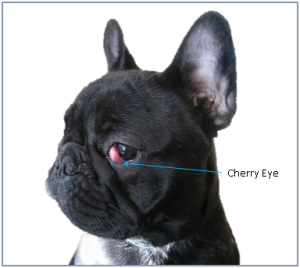 Cherry eye is simply a swollen gland from the third eyelid. It looks like a cherry! The basics are as follows:
Cherry eye is simply a swollen gland from the third eyelid. It looks like a cherry! The basics are as follows:
- In itself it is of no immediate emergency or concern
- About 20% are not a long term problem and can initially be managed until they resolve, so give them that chance. (See below)
- About 80% are a chronic intermittent problem or permanent, in which case they should be surgically corrected
- You do NOT need a specialist to do these. If your general surgeon is very experienced, it is a relatively simple surgery for a skilled surgeon
- There is a potential failure rate with surgery, even with specialists, so be aware of this and ask your preferred surgeon what the chances are of it reoccurring
- The skill and experience of the surgeon can also dictate the long term look of the corrected cherry eye. With more experience, it will be less likely to be bulbous or red (or indeed less likely to recur)
- Cost can vary greatly, as a comparison you can refer to our costs and success rate
Managing Cherry Eye Before Surgery
To manage these quite simply, gently massage the cherry eye and many will pop back in. Ask your vet clinic to show you (our nurses offer this for no charge), or look at Youtube examples. If in itself this does not work, then steroid drops often help facilitate this by reducing the swelling. Now we strongly recommend the following points here:
- Many vets reach for ointments with antibiotics
- We urge vets not to use ointments as these are often quite irritating and this is not a bacterial condition, so topical antibiotics do not help
- Some of the ointments have steroids in them which can help (but the concentration is less than ideal), but again being an ointment, they are more irritant than solutions or drops
- As such we recommend Maxidex pure steroid solution (or drops) as the initial medication if massage alone is not significantly effective
- If using massage and drops, ideally the cherry eye should reduce within 2-3 days.
Surgery
We recommend surgical correction if:
- The cherry eye is non reducible for more than 2 weeks
- The cherry eye is consistently a problem, popping in and out, for more than 2 months.
- Please note: The longer a cherry eye remains out, the higher the chance it results in cartilage damage that results in a more difficult correction, and less pleasing long term aesthetic result
There is a cheap and easy old technique that just cuts the cherry eye away. This can work and be successful, but there is a significant chance that later on in life dry eye occurs, as the gland is partly responsible for the tear film. Dry eye can be a difficult and very expensive condition to maintain for the rest of your dogs life, hence quality surgeons do not recommend this procedure. It’s quite easy to do compared to surgical correction of the eye, but is not in the patients best interest. You are really rolling the dice with both your dog’s health and ultimately your own finances if you end up with a dry eye.
Correct surgical technique will reduce the cherry into a pocket and will be stitched down holding it in place, but preserving the gland. They can be a little inflamed for a few days to a week or two but most settle down back to normal. Some can retain a little prominence, but the chance of this is significantly reduced with experience and skill of the surgeon.
There is a potential recurrence rate no matter the surgeon, specialists included, that again will be less with more skilled and experienced surgeons. There also seems to be a vast price difference for this procedure within our profession from clinic to clinic. Our price range is as follows:
If done on top of another procedure such as desexing or airways or both: *$560 per eye.
If done as an isolated procedure: *$950 for the first eye plus $560 if both need to be done.
Please note, the above prices do not include potential extras such as surgical fluids or pre-anaesthetic blood screens.
Our surgeons are yet to have a recurrence of a surgically corrected cherry eye, but it is always possible.
